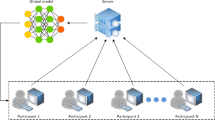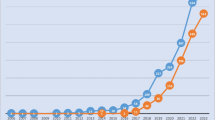Abstract
In recent decades, user communication has been digitalized with some advanced applications. However, securing the digital cloud system is complicated because of the vulnerability of large files and malicious events. Therefore, a present research study intended to design a novel Dragonfly-based Genetic Deep Belief Network (DGDBN) technique to protect the VM from malware activities in the cloud environment. Hence, to validate the presented model, the cloud user files data was considered and imported to the system as input. Then further processes such as preprocessing feature extraction, attack detection and classification were performed. Once the malicious event is predicted, it is neglected by the cloud user environment. Furthermore, implemented novel DGDBN model is tested in the MATLAB programming environment. Finally, the performance parameters like accuracy, precision, reconfiguration time, Recall, F-measure, and data overhead were measured and compared with associated approaches. The novel DGDBN scored the highest accuracy at 99.6%, reduced reconfiguration time at 320 ms and optimized data overhead at 24.2%. Hence, it is in optimal status compared to the existing models.








Similar content being viewed by others
Data availability
Data sharing not applicable to this article as no datasets were generated or analyzed during the current study.
References
Dennis, J. B., & Priya, M. S. (2021). A profile-based novel framework for detecting EDoS attacks in the cloud environment. Wireless Personal Communications, 117, 3487–3503. https://doi.org/10.1007/s11277-021-08280-y
Vashishtha, L. K., Singh, A. P., & Chatterjee, K. (2022). HIDM: A hybrid intrusion detection model for cloud based systems. Wireless Personal Communications. https://doi.org/10.1007/s11277-022-10063-y
Geetha, R., Suntheya, A. K., & Srikanth, G. U. (2020). Cloud integrated IoT enabled sensor network security: Research issues and solutions. Wireless Personal Communications, 113, 747–771. https://doi.org/10.1007/s11277-020-07251-z
Zhao, S., Miao, J., Zhao, J., & Naghshbandi, N. (2023). A comprehensive and systematic review of the banking systems based on pay-as-you-go payment fashion and cloud computing in the pandemic era. Information Systems and e-Business Management. https://doi.org/10.1007/s10257-022-00617-9
Sheik, S. A., & Muniyandi, A. P. (2023). Secure authentication schemes in cloud computing with glimpse of artificial neural networks: A review. Cyber Security and Applications, 1, 100002. https://doi.org/10.1016/j.csa.2022.100002
Radhika, E. G., & Sadasivam, G. S. (2021). Budget optimized dynamic virtual machine provisioning in hybrid cloud using fuzzy analytic hierarchy process. Expert Systems with Applications, 183, 115398. https://doi.org/10.1016/j.eswa.2021.115398
Zhou, G., Tian, W., & Buyya, R. (2023). Multi-search-routes-based methods for minimizing makespan of homogeneous and heterogeneous resources in Cloud computing. Future Generation Computer Systems, 141, 414–432. https://doi.org/10.1016/j.future.2022.11.031
Aslan, Ö., Ozkan-Okay, M., & Gupta, D. (2021). Intelligent behavior-based malware detection system on cloud computing environment. IEEE Access, 9, 83252–83271. https://doi.org/10.1109/ACCESS.2021.3087316
Melvin, A. A., Kathrine, G. J., Pasupathi, S., Shanmuganathan, V., & Naganathan, R. (2022). An AI powered system call analysis with bag of word approaches for the detection of intrusions and malware in Australian Defence Force Academy and virtual machine monitor malware attack data set. Expert Systems. https://doi.org/10.1111/exsy.13029
Dawson, J. A., McDonald, J. T., Hively, L., Andel, T. R., Yampolskiy, M., & Hubbard, C. (2018). Phase space detection of virtual machine cyber events through hypervisor-level system call analysis. In: 2018 1st International Conference on Data Intelligence and Security (ICDIS), IEEE. https://doi.org/10.1109/ICDIS.2018.00034
Kim, H., Kim, J., Kim, Y., Kim, I., & Kim, K. J. (2019). Design of network threat detection and classification based on machine learning on cloud computing. Cluster Computing, 22(1), 2341–2350. https://doi.org/10.1007/s10586-018-1841-8
Abdullayeva, F. (2019). Malware detection in cloud computing using an image visualization technique. In: 2019 IEEE 13th International Conference on Application of Information and Communication Technologies (AICT), IEEE. https://doi.org/10.1109/AICT47866.2019.8981727
Srinivasan, S., & Deepalakshmi, P. (2023). ENetRM: ElasticNet Regression Model based malicious cyber-attacks prediction in real-time server. Measurement: Sensors, 25, 100654. https://doi.org/10.1016/j.measen.2022.100654
Takase, H., Kobayashi, R., Kato, M., & Ohmura, R. (2020). A prototype implementation and evaluation of the malware detection mechanism for IoT devices using the processor information. International Journal of Information Security, 19(1), 71–81. https://doi.org/10.1007/s10207-019-00437-y
Praveena, D., & Rangarajan, P. (2020). A machine learning application for reducing the security risks in hybrid cloud networks. Multimedia Tools and Applications, 79(7), 5161–5173. https://doi.org/10.1007/s11042-018-6339-0
Zhou, H., Zheng, Y., Jia, X., & Shu, J. (2023). Collaborative prediction and detection of DDoS attacks in edge computing: A deep learning-based approach with distributed SDN. Computer Networks. https://doi.org/10.1016/j.comnet.2023.109642
Basu, S., Kannayaram, G., Ramasubbareddy, S., & Venkatasubbaiah, C. (2019). Improved genetic algorithm for monitoring of virtual machines in cloud environment. Smart Intelligent Computing and Applications (pp. 319–326). Springer, Singapore. https://doi.org/10.1007/978-981-13-1927-3_34
Zhang, W., Chen, X., & Jiang, J. (2020). A multi-objective optimization method of initial virtual machine fault-tolerant placement for star topological data centers of cloud systems. Tsinghua Science and Technology, 26(1), 95–111. https://doi.org/10.26599/TST.2019.9010044
Soni, J., Peddoju, S. K., Prabakar, N., & Upadhyay, H. (2021). Comparative analysis of LSTM, one-class SVM, and PCA to monitor real-time malware threats using system call sequences and virtual machine introspection. In International Conference on Communication, Computing and Electronics Systems (pp. 113–127). Springer, Singapore. https://doi.org/10.1007/978-981-33-4909-4_9
Ntambu, P., & Adeshina, S. A. (2021). Machine learning-based anomalies detection in cloud virtual machine resource usage. In 2021 1st International Conference on Multidisciplinary Engineering and Applied Science (ICMEAS), IEEE. https://doi.org/10.1109/ICMEAS52683.2021.9692308
Yilmaz, F., Sridhar, M., Mohanty, A., Tendulkar, V., & Hamlen, K. W. (2021). A fine-grained classification and security analysis of web-based virtual machine vulnerabilities. Computers & Security, 105, 102246. https://doi.org/10.1016/j.cose.2021.102246
Saleem, M., Warsi, M. R., & Islam, S. (2023). Secure information processing for multimedia forensics using zero-trust security model for large scale data analytics in SaaS cloud computing environment. Journal of Information Security and Applications, 72, 103389. https://doi.org/10.1016/j.jisa.2022.103389
Zhao, W., Yue, S., Fei, M., Chen, R., & Wei, L. (2023). A new cloud computing deployment model: Proprietary cloud. Signal and Information Processing, Networking and Computers: Proceedings of the 10th International Conference on Signal and Information Processing, Networking and Computers (ICSINC) (pp. 130–137). Singapore: Springer. https://doi.org/10.1007/978-981-19-9968-0_16
Ali, M., Jung, L. T., Sodhro, A. H., Laghari, A. A., Belhaouari, S. B., & Gillani, Z. (2023). A Confidentiality-based data classification-as-a-Service (C2aaS) for cloud security. Alexandria Engineering Journal, 64, 749–760. https://doi.org/10.1016/j.aej.2022.10.056
Alkadi, O., Moustafa, N., Turnbull, B., & Choo, K. K. (2020). A deep blockchain framework-enabled collaborative intrusion detection for protecting IoT and cloud networks. IEEE Internet of Things Journal, 8(12), 9463–9472. https://doi.org/10.1109/JIOT.2020.2996590
Tian, D., Ying, Q., Jia, X., Ma, R., Hu, C., & Liu, W. (2021). MDCHD: A novel malware detection method in cloud using hardware trace and deep learning. Computer Networks, 198, 108394. https://doi.org/10.1016/j.comnet.2021.108394
Alsarhan, A., Al-Ghuwairi, A. R., Alshdaifat, E., & Idhaim, H. (2022). A novel scheme for malicious nodes detection in cloud markets based on fuzzy logic technique. International Journal of Interactive Mobile Technologies, 16(3).
Panker, T., & Nissim, N. (2021). Leveraging malicious behavior traces from volatile memory using machine learning methods for trusted unknown malware detection in Linux cloud environments. Knowledge-Based Systems, 226, 107095. https://doi.org/10.1016/j.knosys.2021.107095
Gao, X., Hu, C., Shan, C., Liu, B., Niu, Z., & Xie, H. (2020). Malware classification for the cloud via semi-supervised transfer learning. Journal of Information Security and Applications, 55, 102661. https://doi.org/10.1016/j.jisa.2020.102661
Kumar, S. (2022). An effective ransomware detection approach in a cloud environment using volatile memory features. Journal of Computer Virology and Hacking Techniques, 18(4), 407–424. https://doi.org/10.1007/s11416-022-00425-2
Vaza, R. N., Prajapati, R., Rathod, D., & Vaghela, D. (2022). Developing a novel methodology for virtual machine introspection to classify unknown malware functions. Peer-to-Peer Networking and Applications, 15, 793–810. https://doi.org/10.1007/s12083-021-01281-5
Mishra, P., Gupta, A., Aggarwal, P., & Pilli, E. S. (2022). vServiceInspector: Introspection-assisted evolutionary bag-of-ngram approach to detect malware in cloud servers. Ad Hoc Networks, 131, 102836. https://doi.org/10.1016/j.adhoc.2022.102836
Bhardwaj, A., Mangat, V., & Vig, R. (2020). Hyperband tuned deep neural network with well posed stacked sparse autoencoder for detection of DDoS attacks in cloud. IEEE Access, 8, 181916–181929. https://doi.org/10.1109/ACCESS.2020.3028690
Reddy, M., & Rajput, D. S. (2021). Ternary-based feature level extraction for anomaly detection in semantic graphs: An optimal feature selection basis. Sādhanā, 46(1), 1–6. https://doi.org/10.1007/s12046-021-01570-y
Pal, P., Tigga, A. M., & Kumar, A. (2005). Feature extraction from large CAD databases using genetic algorithm. Computer-Aided Design, 37(5), 545–558. https://doi.org/10.1016/j.cad.2004.08.002
Chantar, H., Tubishat, M., Essgaer, M., & Mirjalili, S. (2021). Hybrid binary dragonfly algorithm with simulated annealing for feature selection. SN Computer Science, 2(4), 1–1. https://doi.org/10.1007/s42979-021-00687-5
Devarakonda, N., Anandarao, S., & Kamarajugadda, R. (2021). Detection of intruder using the improved dragonfly optimization algorithm. IOP Conference Series: Materials Science and Engineering (pp. 012011). https://doi.org/10.1088/1757-899X/1074/1/012011
Ragaventhiran, J., Vigneshwaran, P., Mallikarjun, M. K., Syed, T. A., Prabu, R., & Prisma, M. (2022). An unsupervised malware detection system for windows based system call sequences. Malaysian Journal of Computer Science. https://doi.org/10.22452/mjcs.sp2022no2.7
Acknowledgements
None.
Funding
The authors have not disclosed any funding.
Author information
Authors and Affiliations
Corresponding author
Ethics declarations
Conflict of interest
The authors declare that they have no potential conflict of interest.
Ethical Approval
All applicable institutional and/or national guidelines for the care and use of animals were followed.
Informed Consent
For this type of analysis formal consent is not needed.
Additional information
Publisher's Note
Springer Nature remains neutral with regard to jurisdictional claims in published maps and institutional affiliations.
Rights and permissions
Springer Nature or its licensor (e.g. a society or other partner) holds exclusive rights to this article under a publishing agreement with the author(s) or other rightsholder(s); author self-archiving of the accepted manuscript version of this article is solely governed by the terms of such publishing agreement and applicable law.
About this article
Cite this article
Kumar, V., Shaheen, Rajani, D. et al. Secure Deep Learning Framework for Cloud to Protect the Virtual Machine from Malicious Events. Wireless Pers Commun 131, 1859–1879 (2023). https://doi.org/10.1007/s11277-023-10524-y
Accepted:
Published:
Issue Date:
DOI: https://doi.org/10.1007/s11277-023-10524-y




